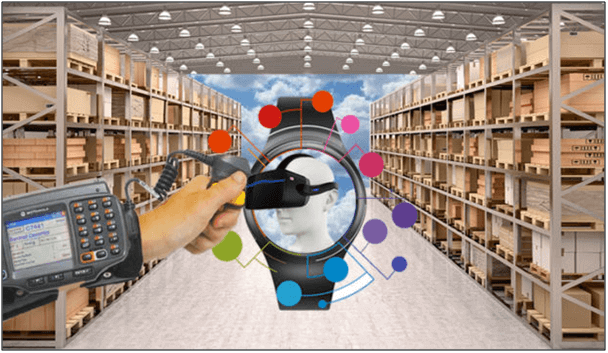Technologies are important components of any business operation in today’s competitive corporate environment. Any business that disregards current information technology will find it difficult to compete. Business management technique that controls the transfer of resources, information, and commodities from one site to another. In integrated logistics operations, smart technologies such as the Internet of Things (IoT), wearable technology, blockchain technology, inventory tracking, automation technology, and serial shipping container code enable accurate, faster, and high-quality items to be delivered to customers just in time. The user by using blockchain technology logistics manage to monitor Inventory monitoring, improve data transparency, resolve disputes, and invoicing and payments. This article discusses the usage of these technologies for integrated logistics operations.
Table of Contents
Internet of Things (IoT)
Internet of Things refers to the widely growing network of connected objects that can collect and exchange data in real-time using fixed sensors. Warehouse and transportation are logistics sectors adopting IoT at scale. IoT systems create a standard for speed and accuracy in integrated logistics operations. Technology also helps businesses ensure superior quality of service while improving overall costs. In terms of integrated logistics management, the IoT platform can continuously monitor the location and condition of goods and assets through wireless sensors and send specific alerts when management abnormalities (delay, damage, theft, etc.) occur. They are the top 8IoT applications for integrated logistics that bring benefits in inventory tracking and analytics, optimized warehouse, real-time fleet management, predictive maintenance, end to end delivery tracking, last-mile delivery innovations, and IoT to business system integration.
Wearable Technology
Material that can be worn on or connected to the body, such as clothing or jewelry. The process of making a high-tech item more user-friendly by making it smaller, less obtrusive, and wearable. Wearable devices such as today’s smartphones, barcode scanners, and tablets are lightweight easy to handle. Wearable devices can monitor and scan the body, such as to provide biofeedback and other physiological functions. This is a device that can be used for many purposes for example to manage work and keep track of important documents. The user saves time by performing activities fast. Wearable technology used in logistics increases productivity to warehousing activity saves time and is paperless. The wristband or spectacles can be used to locate products, process stock, and load the vehicle. Thus, business means lower costs and certified clients. For mobility and disability, both hands should be used.

Blockchain Technology
In today’s global supply chain network, freight brokers are a crucial role because they help complete cargo transactions from shipper to carrier, and they charge additional fees. This led to a significant increase in the cost of logistics service providers. As the complexity of a project increases, the return-on-investment decreases, and how we share data may change. Blockchain-based smart contracts are one way to reduce overhead and reduce the number of middlemen to a large extent. Blockchain can eliminate potential data errors and delivery delays. The companies track each shipment and estimate the delivery time of different routes before calculating delivery costs more accurately. The logistics industry is cutting its costs by improving inventory management.
Inventory Tracking Analytics
Companies can use different methods for transparent inventory tracking. While traditional barcodes are suitable for smart labels, basic inventory and RFID tags offer a much wider range of capabilities for automation and analysis. These IoT-powered methods use tiny microchips that can convey all the information about the products you need and can be updated in real-time for complete visibility into inventory movements. In addition, automatic scanning of inbound and outbound items improves accuracy and reduces error-prone manual intervention. With help of data, the user can plan the demand, improve efficiencies and make better solutions leading to faster inventory turnover and higher profit margins. Automated technology helps us to maximize sales.
The full content is only visible to SIPMM members
Already a member? Please Login to continue reading.
References
Alan@Muralidharan R Pillai, DLSM. (2021). “Smart Technologies for Integrated Logistics Operations”. Retrieved from SIPMM: https://publication.sipmm.edu.sg/smart-technologies-for-integrated-logistics-operations/, accessed 04/12/2021.
Go Jing Yiap, DLSM. (2021). “Smart Technologies for Logistics Service Providers”. Retrieved from SIPMM: https://publication.sipmm.edu.sg/smart-technologies-logistics-service-providers/, accessed 04/12/2021.
Ho Kek Ming, DLSM. (2019). “Six Essential Areas for an Integrated Logistics System” Retrieved from SIPMM: https://publication.sipmm.edu.sg/six-essential-areas-integrated-logistics-system/, accessed 04/12/2021.
Interlake Mecalux, (2021). “SSCC Code: A Unique Logistics ID”. Retrieved from https://www.interlakemecalux.com/blog/sscc-code, accessed 04/12/2021.
Sonia Lai Jie Yin, DLSM. (2018). “Key Success Factors Effective Logistics Practices”. Retrieved from SIPMM: https://publication.sipmm.edu.sg/key-success-factors-effective-logistics-practices/, accessed 04/12/2021.

